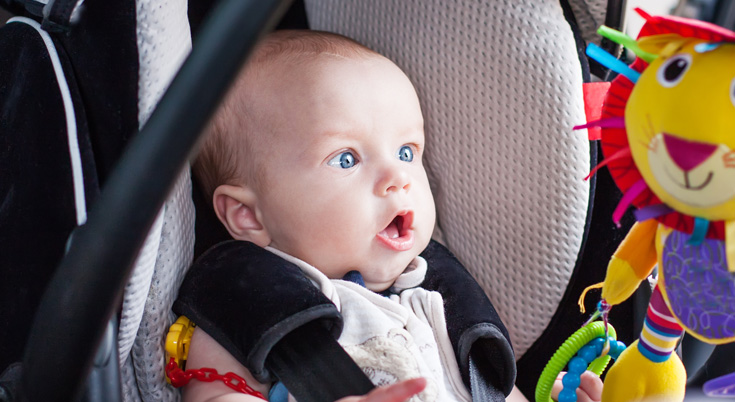

Some babies fall asleep almost before you’re out of the driveway, but others won’t spend five happy minutes in their car seats. Usually, this is because your baby is used to more freedom of movement and more physical attention than you can provide when she’s belted into her seat.
Hearing your baby cry while you are trying to drive is challenging. Even though it’s difficult to deal with, remember that you and your baby’s safety are most important. Parents sometimes take a crying baby out of the car seat, which is extremely dangerous and makes it even more difficult for the baby to get used to riding in the car seat. Some parents make poor driving decisions when their babies are crying, which puts everyone in the car at risk. Either pull over and calm your baby down, or focus on your driving. Don’t try to do both.
The trip to car seat happiness
Any one (or more) of the following strategies may help solve your car seat dilemma. If the first one you try fails, choose another one, then another; eventually, you’ll hit upon the right solution for your baby.
Make sure that your baby is healthy.
If car seat crying is something new, and your baby has been particularly fussy at home, too, your baby may have an ear infection or other illness. A visit to the doctor is in order.
Bring the car seat in the house and let your baby sit and play in it.
Once it becomes more familiar in the house, she may be happier to sit there in the car.
Keep a special box of soft, safe car toys that you’ll use only in the car. If these are interesting enough, they may hold her attention. (Avoid hard toys because they could cause injury in a quick stop.)
Hang toys for viewing.
You can do this on the back of the seat that your baby is facing or attached to the seat. Place them just at arm’s reach so that your baby can bat at them from her seat. (Don’t use hard toys that could hurt your baby if they come loose in a quick stop.)
Experiment with different types of music in the car.
Some babies enjoy lullabies or music cd’s made especially for young children; others surprise you by calming down as soon as you play one of your favourites. Some babies enjoy hearing Mum or Dad sing, more than anything else!
Try “white noise” in the car.
You can purchase CDs of soothing nature sounds or you can make a recording of your vacuum cleaner!
Practise with short, pleasant trips when your baby is in a good mood.
It helps if someone can sit near her and keep her entertained. A few good experiences may help set a new pattern.
Hang a mirror.
That way your baby can see you (and you can see your baby) while you are driving. Baby stores offer speciality mirrors made especially for this purpose. When in her seat, she may think that you’re not there, and just seeing your face will help her feel better.
Put up a sunshade in the window.
This can be helpful if you suspect that sunshine in your baby’s face may be a problem. Use the window-stick-on types, and avoid any with hard pieces that could become dislodged in a quick stop.
Try to consolidate trips.
Trip-chaining is effective, especially if you avoid being in the car for long periods of time, and you don’t have many ins-and-outs.
Make sure your baby hasn’t outgrown her car seat.
If her legs are confined, or her belts are too tight, she my find her seat to be uncomfortable.
Try opening a window.
Fresh air and a nice breeze can be soothing.






















